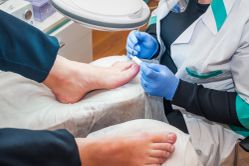A Guide to Infections in Ingrown Toenails

Ingrown toenails are one of the most common issues that podiatrists treat. They occur when the side of your toenail grows incorrectly, penetrating the nail bed and skin. Because this opens the skin, it can lead to infections. Below is more information about how to tell when this happens, as well as your possible treatment options.
What Are the Signs of Infection?
Ingrown toenails occur when the side of your nail grows into the skin. However, this allows both bacteria and fungi to enter the wound and cause an infection. When this happens, the infection can spread to the bone structure of the foot. You should consult a podiatrist immediately if you think your toenail has an infection.
Some signs of an infection include a buildup of fluid or puss around the ingrown nail, as well as a bad smell or blood coming from the toe. Your toenail may also experience yellowing, thickening, and cracking. As the infection spreads, the area around the nail begins to swell and become red.
What Are Your Treatment Options?
 If your symptoms are minor, you can sometimes reduce the pain or resolve the issue at home. First, sanitize your foot thoroughly, and then soak it in warm water with Epsom salts for 15 minutes. Repeat this process three to four times per day to reduce swelling and clean out the area. Then, apply an antifungal or antibiotic lotion to the affected area and cover it with a bandage.
If your symptoms are minor, you can sometimes reduce the pain or resolve the issue at home. First, sanitize your foot thoroughly, and then soak it in warm water with Epsom salts for 15 minutes. Repeat this process three to four times per day to reduce swelling and clean out the area. Then, apply an antifungal or antibiotic lotion to the affected area and cover it with a bandage.
If you don’t see results with this treatment within the first two to three days, call a podiatrist. Depending on the severity of your situation, they might do a toenail lift to prevent it from growing further inward. This requires your podiatrist to lift up the toenail and place a splint underneath. You must replace the splint every day to keep the nail from receding back into the skin.
In more serious cases, your podiatrist may remove the parts of your nail, nail bed, and underlying tissue that has the infection. They will also apply medication to the area to reduce the chance that the nail will grow incorrectly. A few weeks after this procedure, you will have another appointment with your podiatrist to ensure that the ingrown toenail is healing properly and the infection has been treated.
If you’re having issues with an ingrown toenail, call St. Peters Foot & Ankle: Samuel T. Wood-DPM. Dr. Wood is board-certified by the American Board of Podiatric Surgery and serves clients in a 35-mile radius around St. Peters and Florissant, MO. He treats a wide variety of foot issues and can clear up your infected toenail quickly and easily. Visit the website for more information about his services. Call (636) 720-0190 to make an appointment.
About the Business
Have a question? Ask the experts!
Send your question

